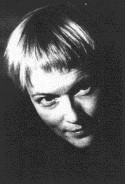
Char Davies
Virtual Artist
www.immersence.com
Char Davies wants to literally immerse you in her art. As a traditionally trained artist, she now experiments with cutting-edge computer technologies to explore already familiar subjects: nature, the body, time, and space. Building on these themes, she then creates interactive virtual environments and invites you to fully participate within these artfully constructed spaces.
A visit to Char’s self-designed Web site www.immersence.com] is the first plunge into appreciating her unique art form. The simple but effective site acts as a virtual gateway to understanding her intricate three-dimensional explorations of nature and also archives her growing body of work.
For almost 20 years, Char has been slowly interweaving her painting techniques, first with film and later with 3-D
computer graphics and animation. As an artist, she was beginning to feel frustrated by the two-dimensional picture frame and began to seek ways to go beyond it. Fuelled by her desire to communicate her ideas, her search finally led her to experiment with computer technology. She also reveals that her move from painting to a new art aesthetic was in part caused by her own near-sightedness. “I turned my attention as a painter to investigating my own extremely myopic eyesight. In doing so, I was initiated into an alternative experience of space whereby “objects had apparently disappeared, where all semblance of solidity, surface, edges, and distinctions between things . . . had dissolved.” Consequently, Char abandoned the medium of painting for that of 3-D computer graphics—a medium that offered “the possibility of creating in virtual three-dimensional on the other side of the picture plane.”
In 1988, Char became the founding director of Montreal-based start-up computer graphic software company Softimage. Taking a slight detour from her art, she and her team focused on business-building and developing state-of-the-art technological tools. Soon, Softimage software became known worldwide as a tool to achieve the epitome of the kind of realism that can be attained with computers. It was even used to animate all of the dinosaurs in the blockbuster film Jurassic Park. Computers were revolutionizing the film industry, and suddenly visual artists were creating an entirely new animated art form.
In her own art, however, Char was much more interested in moving as far away as possible from reality. She began to dabble with her company’s innovative software and soon discovered that the same technological tool that could bring dinosaurs back to life on the big screen could also take her art to a new level of expression within VR or what Char prefers to call “immersive virtual space.”
Since 1994, Char has created two virtual environments, Osmose and Ephémère, drawing on the natural world for her inspiration. To enter these works, you wear a head- mounted display that enables you to see 3-D computer graphics and hear sounds generated in real time by an SGI supercomputer. Char maintains that every person’s journey is different—“What you experience depends on your behavior and location within the work. Your breath and balance are tracked by an interface vest. Breathing in causes you to rise; exhaling causes you slowly to fall. Leaning gently lets you change direction.”
Both works reveal Char’s unique and personalized version of nature. For 15 minutes, users can travel through forests, move through running water, or delve down through the earth. Images are soft, semitransparent, and luminous; the entire virtual experience is deliberately designed to move away from any common concepts of reality. “I was deliberately seeking to develop an alternative to what most VR was at the time, which was again, hard-edged, based on a kind of an attempt at realism.”
Many of the more than 10,000 people who have been immersed in these two installations reported the experience had triggered a heightened response. Char claims that she didn’t intend to evoke certain emotions in people, or certain experiences. “I wanted to create this alternative, more contemplative, receptive mode. So it surprised me, the first time the work showed publicly, that many people were quite emotionally overcome by it—unprepared, surprised—and would have all these emotional experiences that ranged from euphoria to people crying afterwards, out of a kind of sadness and a nostalgia and a sense of loss that they couldn’t even put into words.”
Char’s choice to design these evocative landscapes stemmed from a desire “to light a lamp in a dark comer,” a phrase she uses to demonstrate to other people that virtual reality is capable of something far more mysterious, and rich, than “shoot-’em-up” games. “I didn’t want to do ‘shoot-’em-up’ games, and this is where, maybe, a more female sensibility comes into play I wanted to create spaces where it wasn’t about ‘doing.’ It was not about running around and doing things, and scoring, and having an adrenaline rush based on speed. I was more interested in creating what I have named ‘a slow rush.’ My environments might foster contemplation, receptivity, heightened perception, and create a situation in which the participant might let go of their desire to rim around, you know, really fast and speedy, and instead let go and just be in the space.”
Char is also cognizant of the importance of her virtual work in a “real” world where we are increasingly losing our ability and perhaps our desire to protect and cherish nature. To some, her immersive installations act as a warning that one day virtual environments might be all we have left. Those who enter her animated, 3-D models are potently reminded of how extraordinary it is to be fully conscious of our natural living world.
This article may include minor changes from the original publication in order to improve legibility and layout consistency within the Immersence Website. † Significant changes from the original text have been indicated in red square brackets.
